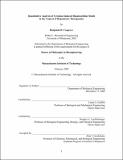| dc.contributor.advisor | Linda G. Griffith and Douglas A. Lauffenburger. | en_US |
| dc.contributor.author | Cosgrove, Benjamin D. (Benjamin David) | en_US |
| dc.contributor.other | Massachusetts Institute of Technology. Dept. of Biological Engineering. | en_US |
| dc.date.accessioned | 2011-02-23T14:31:44Z | |
| dc.date.available | 2011-02-23T14:31:44Z | |
| dc.date.issued | 2009 | en_US |
| dc.identifier.uri | http://hdl.handle.net/1721.1/61221 | |
| dc.description | Thesis (Ph. D.)--Massachusetts Institute of Technology, Dept. of Biological Engineering, 2009. | en_US |
| dc.description | "February 2009." Cataloged from PDF version of thesis. | en_US |
| dc.description | Includes bibliographical references (p. 161-178). | en_US |
| dc.description.abstract | Numerous therapeutics, such as viral gene therapy vectors, have unintended toxicity in part due to interactions with inflammatory cytokine signaling to elicit hepatocyte death, thus limiting their clinical use. Although much is known about how cytokines and certain therapeutics individually induce hepatotoxicity, there is little understanding of how they jointly regulate the complex cellular signaling network governing hepatocellular death. In this thesis, we explored the signaling mechanisms governing the cytokine-induced hepatocellular death in the context of adenoviral vector (Adv) infection and pharmaceutical compounds with idiosyncratic hepatotoxicity. Initially, we examined the role of autocrine and intracellular signaling pathways in governing the synergistic induction of hepatocyte apoptosis by the cytokine tumor necrosis factor-a (TNF) in the presence of Adv infection in a primary rat hepatocyte cell culture model. We demonstrated that Adv/TNF-induced hepatocyte apoptosis is regulated by a coupled and self-antagonizing autocrine signaling cascade involving the sequential release of anti-apoptotic transforming growth factor-a (TGF-a), pro-apoptotic interleukin- 1 a/p (IL-l a/), and anti-apoptotic IL- 1 receptor antagonist (IL- Ira). This three-part autocrine cascade regulates multiple intracellular signal pathways, including ERK and JNK, that serve to integrate TNF- and Adv-induced signals and govern the resultant hepatocellular death response. Following this, we demonstrated that numerous idiosyncratic hepatotoxins, whose hepatotoxicities are not evident in standard cell preclinical screening models, elicit synergistic induction of hepatocellular death upon multi-cytokine co-stimulation in primary rat and human hepatocyte cell culture models. We showed that this drugcytokine co-treatment model could be usefully scaled to the high-throughput demands of pharmaceutical screening while maintaining idiosyncratic hepatotoxicity prediction accuracy. To identify the signaling mechanisms regulating these drug/cytokine hepatocellular death synergies, we collected multi-pathway signal-response data compendia from two human hepatocyte donors. Through the use of partial least-squares regression modeling, we showed that hepatocytes integrate signals from four pathways -- ERK, Akt, mTOR, and p38 -- to specify their cell death responses to toxic drug/cytokine conditions and that accurate prediction of hepatocellular death responses can be made across human hepatocyte donors. Together, these findings demonstrate that cytokine-induced hepatocellular death in the context of hepatotoxic therapeutics is governed by integrated network activity of multiple autocrine and intracellular signaling pathways. | en_US |
| dc.description.statementofresponsibility | by Benjamin D. Cosgrove. | en_US |
| dc.format.extent | 178 p. | en_US |
| dc.language.iso | eng | en_US |
| dc.publisher | Massachusetts Institute of Technology | en_US |
| dc.rights | MIT theses are protected by copyright. They may be viewed, downloaded, or printed from this source but further reproduction or distribution in any format is prohibited without written permission. | en_US |
| dc.rights.uri | http://dspace.mit.edu/handle/1721.1/7582 | en_US |
| dc.subject | Biological Engineering. | en_US |
| dc.title | Quantitative analysis of cytokine-induced hepatocellular death in the context of hepatotoxic therapeutics | en_US |
| dc.type | Thesis | en_US |
| dc.description.degree | Ph.D. | en_US |
| dc.contributor.department | Massachusetts Institute of Technology. Department of Biological Engineering | |
| dc.identifier.oclc | 701386080 | en_US |
